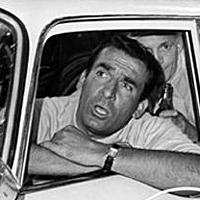
Recently on Cyclingnews.com |
Tales from the peloton, July 28, 2008
Teams vanished and gone
If you look aggressive, are people automatically aggressive with you? How about if you look happy? Do people treat you as a friend? And what if you just look miserable? Cyclingnews' Les Woodland recounts the sad tale of a man who became famous for the races he almost won.

|
The burned-out hulks of teams left by the roadside of the 2008 Tour de France was impressive. First Barloworld - reduced through lack of numbers to Barlovillage - and then the optimistically yellow-clad Sauniers. But they are not alone. Legion are teams which didn't survive the season.
The most entertaining was De Kova, which graced the peloton in pink jerseys in the hope of selling the legs of an aging and somewhat spreading nightclub singer and dancer. Their owner - and the world seems convinced that they were indeed spectacular - was Miriam De Kova, a rich woman used to getting her way. She wanted to be a star. And since she was the widow of a Greek millionaire living in America, she had a head start on those who relied on talent alone. She also had contacts. One of them was Jean-Marie Rivière, who owned a Parisian cabaret theatre called L'Alcazar. Could she come and sing and dance there?
Rivière was presumably not sure. He had a business to run. De Kova was unknown in France and there was no guarantee that she would bring anybody through the door. Perhaps she could do something to publicise herself. When De Kova asked what he suggested, he thought a moment and then invited her to meet two friends who might help.
Rivière was a cycling fan and a friend of the team manager and former rider, Raphaël Géminiani. Géminiani said he would meet De Kova and that he'd bring Jean de Gribaldy with him. De Gribaldy was for decades one of those people who flitted around in cycling, using money, influence and enthusiasm to manage teams such as Flandria and to bring on riders like Sean Kelly. Both men needed a sponsor for the new season and you can imagine the hope in their souls when they got Rivière's call speaking of a rich widow.
It didn't take long for the pair to start selling cycling. The sponsor-seekers painted a magnificent picture, speaking of stars such as Jacques Anquetil and the press and television coverage that he and others had achieved for those who put their money into cycling. Géminiani could talk of the satisfaction of his near namesake, the St-Raphaël apéritif company, whom he had persuaded to back Anquetil and who had been repaid by victory in the Tour de France.

|
Neither Géminiani or de Gribaldy would have promised a Tour win for the team they proposed to De Kova but, without doubt, they said, De Kova would see her name in the Tour peloton and therefore in all the newspapers and on all the TV sets not of France but all of Europe.
"There is only one way to describe her reaction," said the French reporter Pierre Chany, "and that was that she was swept away." How much money the septuagenarian with the magnificent legs and still more striking wallet put into her team has long been lost, but it won't have been cheap. Among those Géminiani proposed to take on was Lucien Aimar, the winner of the 1966 Tour de France.
Aimar was a mercurial rider, troubled by fluctuating fitness and intermittent doping bans. He had ridden for Géminiani in the Bic team, sponsored by a ballpoint and cigarette-lighter company. That was 1969. The team turned out such a disaster that Géminiani waved it goodbye when the race reached his home in Clermont-Ferrand and left his riders to get to Paris by themselves.

|
By 1973, the year that Géminiani entranced De Kova, Aimar was still a curly-haired name but more of a memory. As a sales aid to an American dancer who knew little of cycling, though, he was invaluable. De Kova signed a cheque and Géminiani signed Aimar and 16 other riders whose names meant as little then as they do now. The only thing that made them stand out was their pink jersey with a broad white band. Unless, that is, you count the fact that De Kova supplied the last five riders to reach Paris. Given that only eight team members reached the capital anyway, that is quite a record.
The winner was Luis Ocaña, who could only have smiled at Géminiani's misfortunes. The two had been together at Bic, another company that Géminiani had brought into cycling. When Ocaña complained to the papers that he hadn't been paid, the owner of the company, Marcel Biche, pointed out that the money had left him and been paid into the team's account. He despaired at the less than open nature of cycling and withdrew his sponsorship at the end of that year.
De Kova didn't need to withdraw her own sponsorship. She had no need. Her money had all been spent before the end of the Tour and the team was no more. Its supposed star, Aimar, who came 17th, went off to become a cycling coach and then to run the Tour of the Mediterranean. He and Raphaël Géminiani are still with us. De Gribaldy died in 1987. Nothing more was ever heard of their riders. And Miriam De Kova? I have no idea. Perhaps somewhere there's a wizened old lady who still dreams of singing in a Parisian cabaret. And of the day she saw her name in the results of the Tour de France. Provided, that is, you read them from the bottom up.
Photography
For a thumbnail gallery of these images, click here
Images by AFP Photo
- Raphaël Geminiani celebrated his 80th birthday in 2005.
- Raphaël Geminiani in the team car directing Jacques Anquetil to victory.
Images by Roberto Bettini/www.bettiniphoto.net
- Some teams arrive not in full strength in Paris, but De Kova managed to occupy the bottom five one year.
